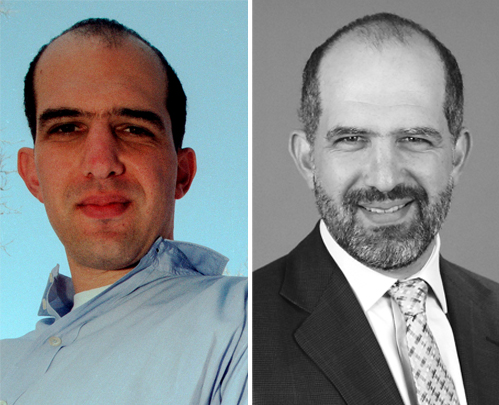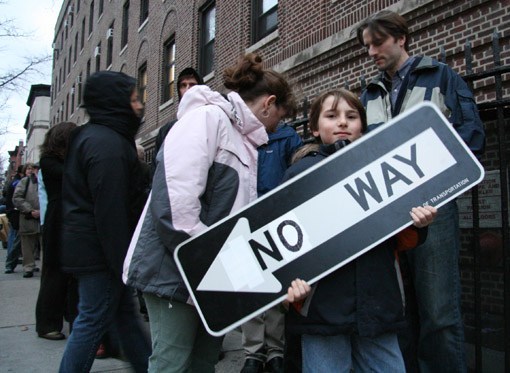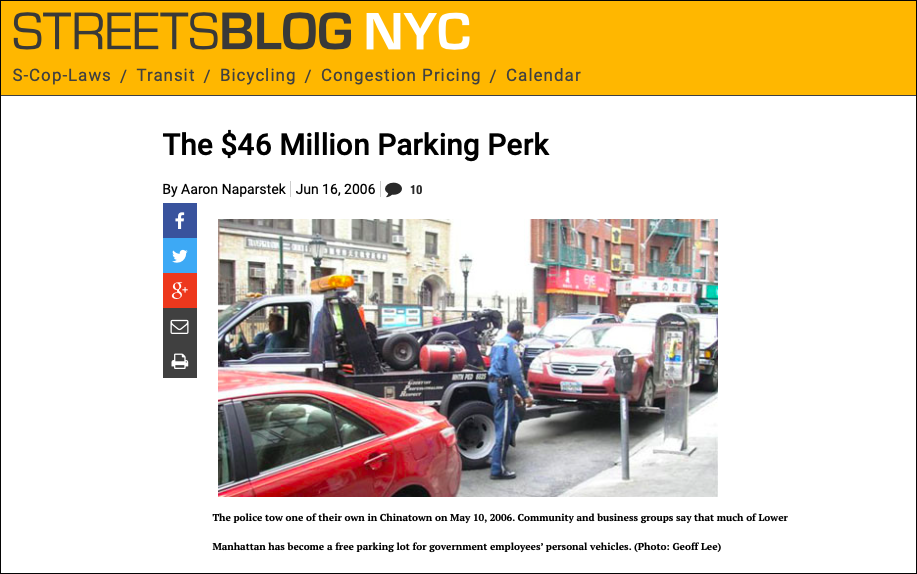On Friday, Streetsblog will hit a true milestone: We will publish our 20,000th post. Since that heady first story in 2006 to today, we've been committed to covering the movement for livable streets and reclaiming our roadways from the automobile. But 20,000 posts is a time to take stock. So we asked founding editor Aaron Naparstek to reflect on how far — and how not far at all! — the movement has come. This is what he told us.

Wow, 20,000 posts. Who’d have thought? Definitely not me.
My first move after Mark Gorton agreed to fund "a daily blog covering the livable streets movement with a goal of adding new transportation policy ideas to the civic agenda and watchdogging and reforming New York City’s Department of Transportation"? I applied to grad school. I mean, sure, I wanted to ban cars from New York City, but I wasn’t insane. It was the winter of 2005. I had a mortgage and a 1-year-old kid. The idea that you could combine the fringe concept of “livable streets” with a hobby called “blogging” and turn that into a viable career? A roll of the dice to say the least.
By the time I got accepted to that grad school program in the summer of 2006 there was no doubt about it. Streetsblog was a thing. There were all kinds of signs and inklings: Walking into the offices of Transportation Alternatives one afternoon and seeing Streetsblog tabs open on every web browser at every desk. Didn’t they have work to do? That steady flow of web traffic, anonymous comments, and juicy tips from nyc.gov and mtahq.org servers (certainly they had work to do). A rumor that Deputy Mayor Dan Doctoroff got into a heated argument at City Hall with DOT Commissioner Iris Weinshall over some criticism he'd read in Streetsblog. Well, now! DOT spokeswoman Kay Sarlin returning my phone calls. Quickly. It was working. Forget grad school.
So, let’s take stock of what’s changed since those heady, pioneering days. Before we even get to the streets, the politics, the advocacy, you have to talk about the media. It’s almost hard to remember what media was like when that first official Streetsblog post went online on June 16, 2006. Twitter was embryonic. YouTube and TheFacebook were fetal. We were still in the artisanal, handmade, horse-drawn carriage days of social media. If I wanted a Streetsblog post to go viral or even just be read anyone, I emailed it to Ben Smith at The Politicker, Lockhart Steele at Curbed or Liz Benjamin at Capitol Confidential and begged for a link.
We had one secret weapon: Google News Alerts. Early on, I had submitted Streetsblog to Google as an official news source. The standards were still in flux and, amazingly, the tech giant accepted our little blog. After that, if I wanted DOT Chief Traffic Engineer Michael Primeggia (and his boss and her boss) to read a Streetsblog post about DOT’s monomaniacally car-oriented approach to engineering its streets, it was as easy as including the words “Michael Primeggia” in a story. The next morning that article would be in a packet of news clippings in the commissioner’s office along with the Times, the News, the Post and everything else. Streetsblog was legit.

And that meant that New York City, all of a sudden, had a publication that approached transportation policy from something other than a windshield perspective. Are you old enough to remember how the New York Times covered transportation issues before Streetsblog? I am! Every so often a reporter would make an expedition out to Brooklyn to observe the natives fighting over a bike lane and some parking spots and jot down some bemused, anthropological study for Sunday's City section. The tabloids and TV news networks reliably did the bidding of the local automobile dealership sponsors. Brian Lehrer and the self-hating bike and transit commuters at WNYC often weren't much better. Maybe they considered the biking and transit community a bias that needed to be balanced off? I don’t know.
In those days, transportation was still mainly an issue to be covered from a helicopter hovering over the afternoon traffic jam in deep sympathy with the beleaguered motorist stuck in said traffic jam. No one bothered reporting on the people who died in the car crash that caused the traffic jam. Traffic was like weather: A natural phenomenon beyond the design and control of mere mortals. It certainly wasn’t a major policy issue like crime, education or housing worthy of serious journalistic treatment. Streetsblog demonstrated that there was a real beat to be covered. And by 2010, copy-cats at WNYC’s Transportation Nation, the New York Times City Room and various other outlets were covering it as we were. Sure, the windshield perspective was there (and still is). But Streetsblog viewed the streets with a fresh set of eyes and demonstrated the validity of a different set of perspectives. And other outlets followed suit. That was a big change.
Just as it’s hard to remember a world before Twitter elected presidents and made Streetfilms go viral, it’s hard to remember how literally and figuratively stuck in gridlock New York City streets were in the early 2000s. Despite the real gains and valiant efforts of then-scrappy, little organizations like Transportation Alternatives and Tri-State Transportation Campaign, the Giuliani/Weinshall era of New York City transportation policy was a grim slog. Protected bike lanes, dedicated bus lanes, car-free streets — all the things that we consider demonstrably successful and normal components of urban life today — these things were considered simply impossible in New York City.
“This is New York City, not Amsterdam!” was the refrain (and still is!). And it was tough to push back because we didn’t have working examples here at home. Sure, London was implementing congestion charging, Paris was turning its riverfront expressway into a park, Copenhagen was steadily removing cars from the city center and Bogota was building out a bus rapid transit system on a shoestring budget, but in New York, DOT Commissioner Iris Weinshall liked to say that her job was “to keep the traffic moving.”
You wanted a bike lane in your neighborhood? DOT would run it by the traffic engineers to determine whether a bike lane would unduly disrupt Level of Service for cars and trucks. And guess what? The answer from the Engineers of Traffic was almost always, “No!” At the time of Streetsblog’s launch, just about everything good and necessary seemed impossible on New York City’s car-choked streets.

By February, 2007, we had one of the first signs that Streetsblog could help build a movement, that we might be a force to be reckoned with: A source at Brooklyn Borough Hall forwarded me a secretive DOT plan, developed by Primeggia himself, to convert the avenues in my very own neighborhood from two-way, mixed-use, people-oriented, retail corridors into speedy, one-way, traffic movers. We posted the secret plan on Streetsblog and began covering it almost daily. On March 15, 2007, a Community Board transportation committee meeting typically attended by 20 people drew a crowd of 700, almost all of whom were there to tell DOT’s Chief Traffic Engineer to shove it. “One way? No way.”
Along with his boss, Weinshall, Primeggia took his pension and left DOT soon after, making way in May 2007 for Commissioner Janette Sadik-Khan and an aggressively progressive new leadership at DOT. Streetsblog was essential in helping to create a new set of standards and expectations. That was a big change, too.
So, where are we today? If Streetsblog was so transformative and all-powerful, why does it seem like New York City’s streets are as crammed with horn-honking, exhaust-spewing, human-squashing, neighborhood-wrecking, glacier-melting motor vehicles as they ever have been? Where did we go wrong? What could we have done better? Allow me to give you the standard-issue, self-aggrandizing job interview answer to that question: In some ways, Streetsblog and the Livable Streets movement have been too successful.
Seriously. A generation of advocates and activists succeeded in convincing a generation of politicians and transportation bureaucrats that it was all about the streets — that stripes of white thermoplast on asphalt could change everything, that small, temporary, tactically poked needles of “urban acupuncture” could transform entire, huge cities. So, while vehicles got bigger, drivers got more distracted, Silicon Valley-funded tech monsters gridlocked our streets with Ubers, the cops ruined Vision Zero, and our urban transit systems crumbled, we were too focused on street design solutions to a set of problems that required a much bigger, broader array of tools to solve.
The result? Here’s one: Jose Alzorriz got killed while sitting on his bike waiting for a red light at Coney Island Avenue and Avenue L in Brooklyn a couple of weeks ago. A kid named Mirza Baig came tearing through the intersection in a 2019 Dodge Charger at extraordinarily high speed. And why not? Dodge spends millions to market the idea that that’s how you drive a Dodge Charger. And New York City does almost nothing to stop Dodge Chargers from being driven like that. Baig flew through a red light, smashed into a minivan and the minivan crushed Jose to death. A review of Baig's driving record revealed that it wasn’t the first time he drove his Charger like a sociopath on Brooklyn streets.
So, what is the de Blasio administration going to do about it? Develop new tools to identify and remove habitually reckless drivers from New York City’s public streets? Nope. We don’t regulate drivers. Ban high-horsepower, gas-burning, personal mobility devices like the Dodge Charger from public streets as we’ve done with e-bikes and e-scooters? Nope. We don’t regulate cars. Lobby to get rid of automobile advertising that encourages deadly driving as we did with tobacco and alcohol advertising? Nope! We don’t regulate automobile marketing. In response to the killing of Jose Alzorriz, Mayor de Blasio’s DOT is going to give us a new bike lane on Coney Island Avenue. A street design solution. Just like we taught them.
It's insufficient, but in a way, you can hardly blame them for doing what we spent years telling them to do.
So as we reach our 20,000 post, here's a hard truth: Streetsblog post number 1 was about government employees abusing their parking placards all over the city. It was called "The $46 Million Parking Perk." You could publish that article today without hardly changing a word of it. In the almost 15 years since we launched Streetsblog, New York and other cities have made all kinds of great changes and improvements. We’ve come a long way! Things have gotten better. And, of course, there’s still a ton of work left to do. But there’s one critical thing we haven’t been able to fix and it’s simply this: Many of the government agencies, employees, contractors and elected officials on whom we depend to solve the problem of New York City’s crushing automobile dependence continue to be the biggest cause of New York City’s crushing automobile dependence.
Until that changes, nothing changes.
Aaron Naparstek is Streetblog's founding editor and a co-host of The War on Cars podcast. Find him on Twitter @Naparstek.






